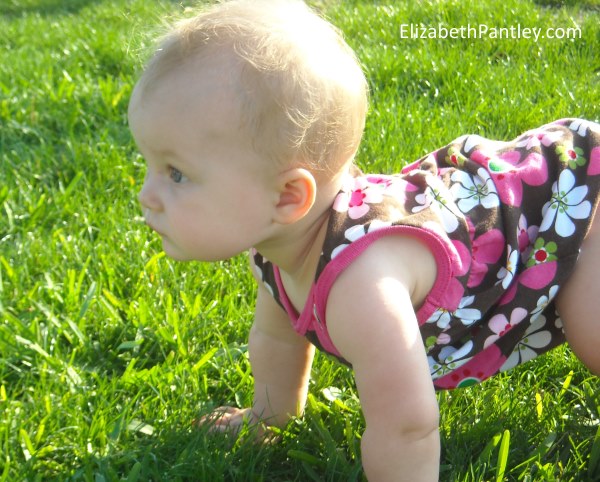
Wait, what? Crawling is a huge part of babyhood! Every parent wonders when their baby is going to start crawling and how they can get their baby moving. Yet it is not a milestone?
Sitting unassisted, standing, and cruising from object to object ... these are physical developmental milestones, but crawling – nope, not on the list! Crawling is not considered a milestone is because not all babies crawl.
Many babies begin to crawl when they’re between six and ten months old; however, there are plenty of perfectly healthy babies who skip the crawling process altogether. Even if your baby doesn’t crawl, he’ll likely find a way to get around. Babies become mobile in many different ways - traditional hands-and-knees crawling is only one way. Babies can get mobile by scooting on their bottoms, rolling around, or going straight to standing, to eventually cruising the furniture and walking!
Whatever your baby’s chosen method of mobility, what’s important is that your little one experiments with moving his arms and legs and finds a way to move around when he’s placed on the floor.
Encourage Your Baby’s Movement
Regardless of the method that your little one chooses, it’s important that you encourage your baby’s movement. Here some things that you can, and should, do to support your child’s physical development:
- Avoid having your baby spend too much time in baby-holders. Devices like swings, bouncers, baby seats and the like are very helpful in keeping your baby safe and happy while you are otherwise occupied, but use them carefully, safely, and in moderation. It’s more valuable to your baby to have that time to explore what their body can do and how it feels.
- Carry your baby frequently. Holding your baby in an upright position helps her develop balance and coordination (a baby sling or carrier is great for this!) A baby who is carried for prolonged periods of time tends to develop good tone in the neck and body and is able to adjust her posture easily in varied positions once she becomes mobile.
- Give your baby plenty of tummy-time play every day. Babies need this time to develop strong muscles and to learn how to use their arms and legs to achieve movement. Don’t feel as though you need to put your baby on his tummy all day long, though, and don’t make him stay there if he isn’t happy. But do make the effort to encourage ample tummy-time play every day. (Remember, though, almost all infants need to SLEEP on their backs!)
- Make the floor a fun place to be. Many babies dislike being on the floor, so they don’t get enough time there learning how to use their bodies. You can help your baby enjoy tummy time by putting him on a clean, smooth surface, and placing an array of interesting toys around him. At first, make it fun by sharing the space with him – get down there and let him know it’s a safe place to be. As he starts to move around, you can add to the fun by using sofa cushions, boxes and other obstacles to help him learn how to climb over and around, and eventually, pull himself up to standing.
- Give her tangible motivation. Your baby might not move if everything she needs is easy to grasp. Place toys just slightly out of your baby’s reach. If everything she wants is always at hand, she’ll have fewer reasons to try to move. Don’t frustrate her, and sometimes encourage her by cheering her on as she figures out how to make her body get to those toys.
- Steer clear of baby walkers. These are proven safety hazards to babies and pose a high risk of accidents. While you may believe that walkers augment the physical development process that leads to crawling and walking, research has shown that they actually slow it down, and that time on the floor is far more important.
When to Be Concerned
If you are ever concerned with your child’s development, you should ask questions of your doctor or health-care provider at a regular well-child visit or with a phone call if it’s between visits.
Take note of your baby’s developmental growth, and how things are changing week to week. Keep in mind that there is a wide range of normal when it comes to physical development. Here are a few situations where it would be a good idea to speak your pediatrician:
- Your baby demonstrates new developmental skills but then stops using them.
- Your baby seems delayed in this area and other skills as well, such as sitting, babbling, and using fine motor abilities.
- Your baby is nearing her first birthday and hasn’t found a way to move around when placed on the floor.
Keep Your Baby Safe
Look at essay for you with safety advice from experts because Childproofing your home becomes extremely important when your baby becomes mobile. A curious, active, mobile baby can move surprisingly fast and can get into amazing amounts of trouble. Your baby does not yet have a sense of which things could be dangerous to him; he simply wants to explore. You will need to watch him like a hawk, won’t be able to turn your back, and will need to always be aware of potential hazards in the environment no matter where you are. Make your home as baby-friendly and baby-safe as possible so that your phenomenal little one can get safely accustomed to the world around him.
Next stage: getting into everything! Find tips for early and respectful discipline in The No-Cry Discipline Solution.



























